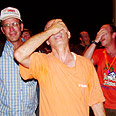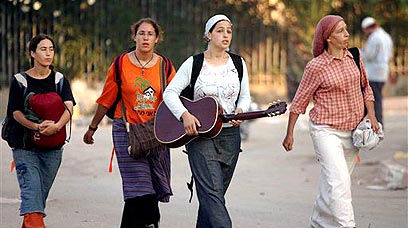


Part One
What, the officers asked settler leader Pinchas Wallerstein during a chat at the police tactical headquarters tent in the southern town of Netivot Tuesday, exactly, are you hoping to accomplish?
Wallerstein leaned his cane on the plastic chair and smiled a cheshire smile: "We want to hold a jamboree," he said.
Jamboree is the annual summer camp of the Scouts youth movement. Thousands of children come together for hikes in the great outdoors. They sleep in tents and sleeping bags before returning home tanned, bitten by mosquitoes, and filled with experiences.

Summer camp?
Perhaps this was indeed nothing but a jamboree.
Innocent trip
During the three days of the march that wasn't to Gush Katif, the pendulum swung wildly from blood to ketchup, from a violent clash with the government to an innocent trip in nature.
Yesterday morning, when this chapter in the battle ended peacefully, everyone praised themselves and each other.
The only one who wasn't interviewed was the weather, even though it made a significant contribution to the decision to disperse: the sun beating down during the day, nearly 40 degrees centigrade (104 farenheit), and humidity at night, enough to make any shirt, no matter how orange, to stick to the chest.
The long walks, from nowhere to nowhere, the sweating babies in their cribs, the itch of wheat stalks after harvest, the endless queue at the mikvah showers.
Rain for all
According to cliché, when it rains, it rains on everyone.
Not exactly so - at least not when it comes to summer and the flat hills of the western Negev desert. The boys and girls had a blast, but the families wanted to go back home.
During the marathon talks held throughout the three days, all kinds of ideas were raised in a bid to find an excuse to fold.
One ideas was to hold a mass rally Thursday in front of Ariel Sharon's private residence, Sycamore Ranch, and end it there.
But the police quickly realized the potential of such a demonstration: the masses, who so much wanted to storm the fence at Gaza's Kissufim crossing, would find an outlet at the fence around Sharon's ranch.
They said no.
21,000 officers available
Thursday morning, Southern District Police commander Uri Bar-Lev convened a meeting with IDF and police commanders for some concluding remarks.
At the height of the event, Bar-Lev had at his disposal 21,000 police officers and soldiers - the kind of force only the IDF Chief of Staff has at his disposal, and only at times of war.
It's a seductive, intoxicating experience, and Bar-Lev met the challenge.
No winners
Now that the battle is over, for the time being, he knew he mustn't say he won. In such battles, whoever says "I won" loses.
Internal Security Minister Gideon Ezra was pleased: he praised the army chief, police chief, district commander, command chief, and the police officers and soldiers, who even after nights in the field, without sleep, were able to take the demonstrators' insults and show restraint.
He also lauded settler leaders for their moderation, and particularly Knesset Member Effie Eitam.
One intervention
During the three days of the march Ezra was around, usually at the Ein HaShlosha headquarters, but intervened only once, the first night.
Police stopped the marchers in the middle of the road between Netivot and Kfar Maimon. Let them continue, he said, you can't get them stuck like this, in the middle of the field.
During the last night, he made an appointment with Yesha Council leaders at 11:30 p.m. The meeting was set for the police's tactical headquarters erected behind the row of cypresses, in front of the entrance to Kfar Maimon.
But they never showed up. They realized they were out of cards to play - the game was over.
Ezra waited for them for two hours, and went home.
The intention, which was partly rhetorical and partly practical, to bring thousands of marchers to the Kissufim Crossing and break through by force, was thwarted.
It was thwarted without spilling blood, following one short and limited violent clash. The forces managed to gather all pullout objectors in one place, and surround them.
These achievements boost the confidence of the commanders ahead of the next phases, which will be less pleasant and more critical.
Tuesday night, Police Chief Moshe Karadi met with settler leaders. The meeting was called in a bid to find a way to get them to step back with dignity.
Ezra is convinced that was the decisive session. "I won't allow you to walk to Gush Katif," the police chief said. "I can't."
Once they realized he meant what he said, the discussion focused on, for all intents and purposes, the question of what kind of image they wanted to leave Kfar Maimon with.
Was it a photo of settlers hitting a soldiers, soldiers hitting a settlers, a wild, dangerous charge on the gates, or a controlled, quiet, dignified protest.
Common interest
Within the masses crowded on Kfar Maimon's roads were those who were looking for action. Police found some people in the crowd handing out wire cutters. An intelligence officer promptly turned to Wallerstein and warned him.
"When I hit, I lose when it comes to public opinion," Yesha Council Chairman Bentzi Lieberman said, "and when I get hit, I lose when it comes to public opinion. We fight for shaping national perception."
Low blow
Tuesday afternoon, Lieberman was standing with his colleague Ze'ev (Zambish) Hever near Kfar Maimon's eastern gate. Southern District police intervention forces were besieging the gate, in a bid to block the settler's march imminent charge forward.
A police officer walked over to Lieberman and grasped him tightly. The policeman's left elbow was placed under Lieberman's chin, while his right hand was sent to the crotch and pressed for the first time in his public service career.
"It's unbelievably painful," he said once he regained his composure.
Good Morning
Tuesday at dawn, a day after the journey from Netivot to Kfar Maimon, Knesset Member and Kfar Maimon residentYitzhak Levy took his friend Rabbi Shlomo Aviner to Netivot, 9 kilometers (6 miles) away, to pick up the rabbi's car.
They left early. On their way they saw families of marchers sleeping by the side of the road. Elsewhere, they met a single protester who extricated himself from his sleeping bag only to find himself surrounded by 400 soldiers.
For Levy, it was a pretty, pastoral picture.
The Yesha boys stood on the inside of the Kfar Maimon fence and spoke to the male and female soldiers standing before them.
Some swore. Others yelled at them to refuse orders, immediately, while others were pleading.
The soldiers were silent. They attempted to look to the side, or bury their eyes in the ground. Not because they were ashamed, but rather, because for Israelia, soldier and civilians alike, find it extremely difficult to absorb and remain silent, to allow the other side to get the last word in.
No insubordination here
Every insubordinate soldier enjoys media fame, but the story, at least for the time being, is the disobedience that isn't there.
According to the IDF's Judge Advocate General, Brigadier General Avi Mandelblit, the number of officers and soldiers who refused order as of Wednesday reached 85, including the officers and reserve soldiers of the Binyamin brigade, who refused half-heartedly.
During the left-wing wave of refusal, about a year ago, there were close to 500 insubordinate soldiers according to the army.
The difference between the two numbers is telling.
It's true that the Left had no rabbis who pretended to serve as an alternate authority to IDF commanders, and it's true that the Left didn't have a large public that backed insubordination openly.
It is also true that it's too early to draw conclusions - the extent of right-wing disobedience would only be examined in three weeks, when soldiers are called to evacuate the settlers from their homes.
Chief-of-Staff Dan Halutz met with hesder yeshiva heads this week. He got the impression they are intimidated by more radical rabbis than them. They are willing to speak out against insubordination to his face, but are unwilling to do so openly.
They drafted a paper Halutz found reasonable, but they were afraid to publicize it.
Tit-for-tat
Halutz intends to pay them back after the pullout. Insubordinate yeshivas will no longer enjoy the status of hesder yeshivas (whose students serve in the army for a year and four months), and their students will be drated for the full three years like other soldiers.
Rabbis who are calling for disobedience will have to make a living elsewhere.
As for hesder soldiers who refuse orders, each will be tried by his commander. Toughness, that's the message coming out of the army chief's office.
Halutz understands the pain, but recommends that those who are hesitant to act as he was once taught to do, during his pilot training course, when facing "extreme situations" - say your army ID number and bite your lips.
He's upset about those who confuse hesder yeshivas and preparatory army programs for religious youngsters. Graduates of the prep programs complete a full military service. Indeed, the programs produce more IDF officers than any other system.
He doesn't want to throw out the baby with the bath water.
Read Part Two
Nahum Barnea is a columnist for Israel's leading newspaper Yedioth Ahronoth
















